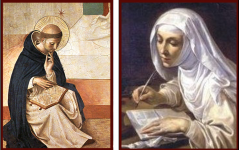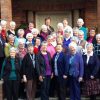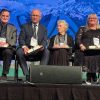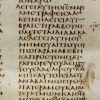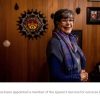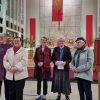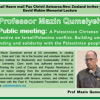 DOMINICAN LAITY
DOMINICAN LAITY
Newsletter #24
October 2012
Dear Friends
There’s so much going on at present! Just consider:
- 50 years since the opening of the Second Vatican Council
- The Year of Faith
- The New Evangelisation
- Ongoing celebration of 800 years of Dominican life
There is no chance of ignoring the call if you’re a Christian today! For many of us Dominicans, all four of these events are brought together in revisiting some of the documents of Vatican II. Or you may be interested in reading a new book, published posthumously, by the noted Dominican Council peritus (expert), Yves Congar OP: My Journal of the Council
25 October was a special day in the history of Santa Sabina basilica in Rome, the mother church of the Dominican Order. Read – and see – about it at this website:
http://www.op.org/en/content/santa-sabina-crown-adventino
At that same site (www.op.org) there is also a most interesting interview with Cardinal Christoph Schönborn OP, Archbishop of Vienna, one of the most impressive figures in the global Church – and often spoken of as a possible candidate for the papacy.
………………………………………………………………………………………….
OBITUARY:
SISTER MARIA McDONALD OP
It is a great privilege in life for us to know a person who is thoroughly good. It deepens our awareness of God and gives us great hope and confidence. For us her Sisters, her family and friends, Sister Maria was, above all, a thoroughly good person. Her Irish parents were filled with faith in and love of God and handed on these precious gifts to their six children. Michael and Joanna McDonald farmed the North Shore land given to the Catholic Church by those pioneering laity, Mary and Thomas Poynton, land around where Carmel College and the North Shore Hospital now stand. Later, they farmed Church land now used by Hato Petera College and the Warehouse headquarters. The McDonald family were deeply loyal Catholics who served the church and were particularly good to priests and religious. Maria, their eldest, was a first day pupil of the Dominican primary school in Northcote, and then went to St Mary’s College for her first three years of secondary school. All her life she has been a committed Mercy ex-pupil. Because she wanted to join the Dominicans, Maria went to St Dominic’s College in Dunedin for her final secondary years, and joined the novitiate soon after leaving school.
Sister Maria has lived her commitment to religious life for over seventy years. She trained as a school teacher and a speech and drama teacher (F.T.C.L.) and then graduated B.A. from the University of Otago. She taught in Dominican schools from Invercargill to Auckland and was often in school administration. She was the first Principal of St Dominic’s College, Henderson. She won awards for her contribution to Catholic Education from both Church and State. In 2002, Sister Maria won a National Education Multi service Award for her outstanding contribution to St Dominic’s College. She retired from teaching when she was seventy one years of age, but a few weeks later the Principal at St Dominic’s asked her to return to fill a vacancy for a French teacher. She soon was also involved as a teacher of English as a Second Language and assisted those who needed special tuition. For the last ten years she taught languages for Years Twelve and Thirteen. She filled her teaching roles enthusiastically until the end of 2010. So teaching in all its aspects has been central to Sister Maria’s life. This is recognized in the book: God’s Honours Board published in August 2012.
This outline in no way reveals who Sister Maria has been for so many of us who knew her as a teacher, and then as the school Principal when we began teaching. Those of us who have been her friends valued and respected her, and appreciated her wisdom and sound advice, which seemed to be the fruit of responding to God’s grace over the long years of her life. She loved her brothers and sister, and their families dearly, helping them where she could, but was never pushy or interfering. Sister Maria was generous, tolerant, hard working,
and a great story teller. Her dramatic skills, supported by a very funny sense of humour, endeared her to young and old alike. Her pupils loved her and she was held in high esteem by those who worked and taught with her. There was nothing small or petty about Sister Maria. She had a big mind and heart. She was a person of integrity, with few prejudices, and piles of common sense. She didn’t take herself too seriously. She was a good judge of character, although her natural tendency was to trust people, and this encouraged trust and confidence in others. Sister Maria was a prayerful woman, dedicated to truth. She spoke her mind forcefully if she considered this necessary. Many a superior was left in no doubt what Sister Maria expected her to do. During the past nineteen years when she has lived at Blockhouse Bay, Sister Columba, her lifelong friend, has provided Maria with special care which has enriched her quality of life.
Latterly, Sister Maria has suffered many health problems, with frequent visits to Auckland Hospital. She was always grateful for the care she received there. She was gracious to visitors and there was never any need to cheer her up.. On 21 October, her condition deteriorated. she moved into deep unconsciousness and died very peacefully at 11.20 p.m. .
The Rosary and Requiem Mass took place in St Dominic’s College Chapel. The girls formed a guard of honour from the gate to the Chapel. A Maori welcome began the ceremonies, Monsignor Kiely officiated. Bishop Pat changed longstanding arrangements to be free to be the Requiem celebrant. Celine Kearney, a niece, gave the one eulogy Sister Maria allowed.. Our memory of Sister Maria continues to inspire us. She will be missed, but the good she has done lives on. Sister Maria has preached the truth well.
Sister Patricia Hannan
We recall also the recent death of mothers of two lay Dominicans: Trish Corboy-Carr and Peter Culloty. May their souls, and the souls of all our dear departed friends, rest in peace.
………………………………………………………………………………………..
THE FOUR PILLARS: PRAYER
This is the first of a series of articles about the Four Pillars of Dominican life. Recently a number of lay Dominicans were invited to share their experiences of prayer. Prayer is at the centre of Dominican life and yet it is such a deeply personal part, and we are privileged to be offered this opening into the spirit – and the Holy Spirit – of our contributors.
From Willie Campbell, Dunedin
I cannot remember a life without prayer. When I was small child, my mother would sit on my bed and begin my day with a morning prayer that thanked God for the blessing of sleep and refreshment and asked Him to be with me during my day to watch and guide me. At night before she tucked me in she again would sit on my bed and thank God for my day (often saying specifics to be thankful for) and be sorry for any failings and ask for strength to overcome these. Any car journey began and ended with prayer- asking and thanking for the safe journey. Often during the journey she would read psalms of which she was particularly fond.
These structures that bounded my day and my movements were reinforced by visits to Catholic aunts and cousins in Edendale where saying the Rosary after tea, kneeling on the kitchen floor and having elbows on the chair, was an essential part of the evening, regardless of who was present. The years with the Dominican Sisters added a midday Angelus to this.
My current prayer life has a very similar pattern. It enfolds my day and structures my relationship with God. It is as ever-present as breathing. As with breathing from time to time I need to focus, refresh and energise my prayers in both form and content. I use prayers from our catholic heritage such as the Our Father and St Patrick’s Breast Plate. I have a well worn “Living Water” prayer book, published in 1978 by the Paulist Press. I use the Psalms both traditional and contemporary-such as those by Joy Cowley. The internet gives great resources- a useful site is http://www.prayingeachday.org/100Prayers.pdf
(The prayer site of the De La Salle Brothers).Because I like chanting and singing and find that the physical actions involved take more energy and focus me rather more completely than spoken prayer I frequently have periods of chanting or singing a prayer.
Whatever prayers I engage in will always be a mixture of thanks, supplication and simple conversation to enrich my relationship with and awareness of God. I find that if I don’t put an appointment time in my diary I can lose some of my prayer time so I am quite disciplined about that. I have been recently introduced to this prayer:
Stay with me Lord, so I do not forget you, you know how easily I abandon you.
Stay with me Lord, for I am weak and need your strength.
Stay with me Lord, for you are my life and I have no fervour without you.
Stay with me Lord so that I may hear your voice and follow you
Stay with me Lord, for you are my light and without you I am in darkness.
Stay with me Lord, for I desire to love you and be in your company.
Stay with me Lord, today and tonight, in life with all its dangers I need you.
Stay with me Lord, for it is you alone I look for, your love, your grace, your will, your spirit.
With a firm love I will love you with all my heart while on earth and continue to love you perfectly through all eternity.
Amen.
From Mary Woods, ex- Christchurch, now Paraparaumu
For me prayer is relationship with God. But who is God?
When I was a child prayer was the family Rosary after tea at night, each taking our turn to lead: “Don’t mumble”. It was also part of long car journeys. The Memorare, prayed desperately on my knees by my bed, was a foolproof method of passing exams. Prayer was about asking and receiving. At boarding school next to St Joseph’s Cathedral, prayer moved to Church. It was about ritual, music, candles, incense and mystery. God was distant yet comforting. I yearned for the closeness of my family.
In the 1960s Vatican II brought change. The Mass, now in English, moved to centre stage and lay people became active participants rather than passive attendees. The ritual became more flexible to include touch and occasional dance. Prayer was an expression of the body as well as the spirit. Study, discussion and informal prayer became important too. God came closer.
My prayer has evolved with age. Life taught me lessons with the births and deaths of children. I learnt to walk the hills alone exploring a piece of scripture and did the same in a group with other women. God is Mother as well as Father. All of creation connects us with God.
I often find God in the unexpected. When I screamed out to God in terror as the earthquake shook, I felt abandoned. I later realized that I was cradling God in the form of my grandson who was digging his terrified teeth into my forearm. God is vulnerable with us.
One day I left a meeting early, pleased with the input I’d given. As I stepped out onto a wet street my unfamiliar “heels” gave way and I was spread-eagled over the pavement with my briefcase flying open. Was it God who wove across the footpath with an inebriated gait and breathed on me and helped me up and said “Are you all right Lady?”
Today the Church’s flexibility is being reined in. When the language excludes me and the messages are more about power and righteousness than love and forgiveness, I feel alienated. I pray more comfortably with groups whose ways are inclusive, focusing on scripture or the writings of mystics, connecting with the rhythms and seasons of life and death.
I can find God in a room full of people but I know God will also be lurking on the beach or in the bush or the sunset, waiting for me to come and have a chat about what is happening in life. In the morning I read the gospel of the day and try to carry it in my head. Mostly it is displaced by mid morning but with Suzanne Aubert I pray “I must do your work, my Lord, then take it all as a prayer”.
From John Collins, Auckland:
When do I pray?
Morning about 6 o’clock, short reading and then meditate for 30 minutes.
I finish with a sign of the cross which I find after meditation has enormous depth and meaning. Then, often a brief prayer for most heartfelt needs of others or self in presence of Jesus.
Evening around 9.00-10.00 o’clock meditate for 30 minutes, preceded by brief reading and brief prayer afterward
Shared prayer-At weekly eucharist, at occasional meetings, at evening meal brief shared blessing
Where do I pray?
At home
At church
Occasionally in groups
Occasionally in other situations such as work or within whatever environment I find myself
How do I pray?
Meditate with mantra-“maranatha”
Pray in awareness of god within and around us
In groups pray in silence and words open to the presence of the Holy Spirit
How does prayer work for me?.
In many ways it takes me to the core of who I am.
Prayer frees me (from fear, malaise, desire) and allows me to be fully present to the people I meet and care for (I am a physician) and to be at home in the place where I am, wherever that is.
From Clare Squibb, Palmerston North
How I pray is varied. I try and be still and try to know what is happening within.
Whatever is within me is a total mystery to me. I continue to try and go within. I try not to ask anything. My mind is a distraction. It keeps interrupting and seems to prevent me going to the core.
I ask God to make me present. .
I ask God to bless and care for specific situations people have asked for prayer for.
I have to remember to say thank you. For my life family friends and country
I pray in the car with people, in the shower kitchen , anyplace really.
My favourite way of praying is to cook and feed and offer hospitality.
I think prayer works, I do not know how, I have been gifted by prayer, my own and other people’s.
From Pat Mullins, Ashurst
My prayer shrine is at the “coal face” of our computer! How up to date is that?
Not really but the Desktop photo has pictures of our family. They are a reminder of the family we belong to which leads to the greater picture of the Trinitarian family of Father Creator, Brother/Sister face of God and our Spiritual Breath of life.
So I start the day in the name of the God who loves us so dearly, lives in us so nearly and guides us in everything we do. At this time I click onto favourites – “Pats Stuff” – which begins with “Daily Reflection Calendar” onlineministries.creighton.edu/CollaborativeMinistry/daily.html
This leads me into an Ignatian prayer site that is for me the best guide to begin my daily prayer.
Among other things it gives the daily scriptures, which can be listened to as well as read, and then a very good reflection video of 2 to 3 minutes.
After this I go to my second favourite that is another Ignation site in Ireland where you will find commentaries on the daily readings.
From these I make a journal of the bits that speak to me each day. Now I move to a more appropriate spot – i.e. the deck, weather permitting, or my bedroom to meditate on what the Spirit has given me on this day.
Before lunch and in the evening before dinner I practice Christian Meditation. Again the computer becomes an aid as the World Community for Christian Meditation wccm.org provides weekly meditations plus heaps of other material to help with this practice. Along with this I have a C.D. which plays reflective music as well as timing the quiet time and ending with reflective music’
From Michele Ness, Paraparaumu
When invited to write about prayer I was reminded me of the monk who went to the abbot and asked, “May I be permitted to smoke whilst I pray?”
The abbot’s response was, “Certainly not!”
Some hours passed and the monk returned to ask, “Is it permitted to pray whilst I smoke?”
“Of course you may,” said the abbot.
A former PP once gave us a most succinct homily on prayer. “I don’t want to see any parishioner here praying whilst driving. I urge you to drive prayerfully instead.”
On the question of road rage he added, “And none of this Catholic attitude, ‘and also with you.” To which he gave an accompanying and popularly known gesture.
This was helpful advice when, some days later, I was stuck behind said PP at traffic lights where he was clearly waiting for a colour he liked…..
Prayer engages my heart as well as my head. As an interior attitude cannot be rushed, or be a matter of pretence, so have I struggled to be engaged with formal prayer. I recognise my need for a time of silence or stillness before litanies, liturgies, novenas, rosaries et al.
Finding time poses another difficulty. Of recent times I have found the recitation of the Divine Office with others has been most helpful in giving structure to my prayer and given me the discipline to set aside a time for prayer and contemplation.
Spontaneity remains important for efficacy of prayer, in fact, quite essential. One of my most memorable moments of devout whole-hearted prayer was shouting “Jesus” as a little chap ran between cars at the school gate. The answer was as if an unseen hand grabbed him by the collar and applied the brakes.
Where do I pray? I remember praying in bed when my then teenagers were out “on the town”. It became routine and the only possible way to get some sleep. It always began, “You know I trust them Lord, it’s all the other silly beggars, their cars, the alcohol, the street violence, their inexperience and naivety, peer pressure and so on before finally I let God take over the night watch. I wonder if they ever knew how frequently I prayed for them and their friends. I never told them just hugged them and said “Thank God” when they emerged next day. Great advice given to me years ago was to talk more to God about friends and family than you talk to friends and family about God.
As the psalmist says “… always and everywhere give thanks…”
………………………………………………………………………………………….
In the next newsletter we would like to continue this series on the Four Pillars, this time with a number of brief articles on STUDY. You are invited to contribute an item. What reading do you do, that helps you live the Christian life? How does your daily activity reveal to you the presence of God in the world? What “breaks open” the Word for you in the world?
500 words max. Send to Mike and Jenny – kelly.wilson@ihug.co.nz
………………………………………………………………………………………….
Donagh O’Shea OP
Many will recall Fr Donagh O’Shea OP, director of Tallaght and the Dominican Retreat Centre in Dublin. He and Sr Angela Campion OP visited New Zealand in 2010 to conduct retreats, which were greatly enjoyed by those who attended. The good news is that Donagh will return in September 2013, for one month, to share with us his gifts and wisdom in the fields of Meditation and Preaching. This visit will be different from last time in that there will not be “live in” Retreats. We are hoping that as many people as are interested and able will have the opportunity to share in some experience yet to be determined. Donagh is willing to travel throughout the country.
If you would be interested in attending a session (one day? Two days? A weekend?) or helping organise a session in your area, please let us know soon ( kelly.wilson@ihug.co.nz ). No dates have been set yet, but an indication of when and where he might go will help the organisers now.
…………………………………………………………………………………………………………….
Visit of Fr David Kammler, Friar Promoter for the Laity
Attached is the calendar for Fr David’s visit – almost, but not completely finished! (We are still waiting to confirm a couple of visit in the south, including one to Christchurch).
Note the people in each area who are acting as contacts for this very exciting visit. You can help by calling your contact to let them know your interest.
Remember to put the dates in your new 2013 calendar!
…………………………………………………………………………………………………………
As Advent approaches, may we be challenged to see God’s vision of what is yet to be,to hear God’s voice calling anew,to smell the scent of God in our world:..
Mike Kelly and Jenny Wilson
Co-ordinators
Ph 06 370 2084 Email: kelly.wilson@ihug.co.nz
